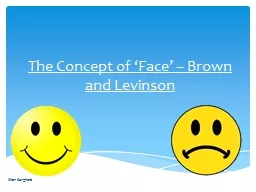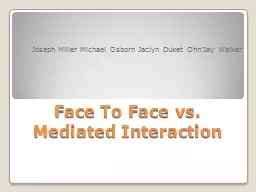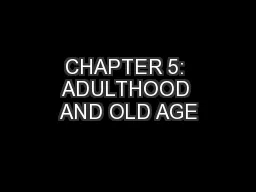PPT-The Concept of ‘Face’ – Brown and Levinson
Author : karlyn-bohler | Published Date : 2016-05-03
Kiran Sanghera Brown and Levinson use the concept of face to explain politeness To them politeness is universal resulting from peoples face needs Positive face
Presentation Embed Code
Download Presentation
Download Presentation The PPT/PDF document "The Concept of ‘Face’ – Brown and ..." is the property of its rightful owner. Permission is granted to download and print the materials on this website for personal, non-commercial use only, and to display it on your personal computer provided you do not modify the materials and that you retain all copyright notices contained in the materials. By downloading content from our website, you accept the terms of this agreement.
The Concept of ‘Face’ – Brown and Levinson: Transcript
Kiran Sanghera Brown and Levinson use the concept of face to explain politeness To them politeness is universal resulting from peoples face needs Positive face is the desire to be liked appreciated approved etc . Supplemental materials for Brest, Levinson, Balkin, Amar and Siegel, Processes of Constitutional Decisionmaking (5 ed. 2006)virtue of a warrant issued upon a formal oath or affidavit; the right of an Monday - read story, p. 17-26 . What is the setting? How does the place affect the plot of the story? Why does this have to be the setting for the story to work?. In the beginning, what is Greg’s problem? What is his immediate solution?. Joseph Miller Michael Osborn Jaclyn . Duket. . Ohn’Jay. Walker. Undergraduate Research. Our thoughts about research in Human Computer Interaction-Design…. Very engaging and large field full of online interactions as well as user based studies that can be carried out. Innatism. Today we will be considering the following criticisms of Concept . Innatism. :. Alternative explanations for proposed innate ideas.. Locke’s arguments against . I. nnatism. Innatism’s. reliance on the non-natural.. Simon Wood. @MrSimonWood. Recording.... We . record our sessions. http://walesdtc.ac.uk/onlinematerials. But what about the live experience?. Asking questions?. Discussion?. (On Air). Welsh Video Network/JVCS. Topic 7: . Section . 2. TIMELINE. Part 1 Directions. : (30 points). In pairs, using your copy of “. Trial of John Brown: A Chronology” . and the Google Map of John Brown’s travels linked on the next slide, create a timeline displaying FIFTEEN dates:. InterContinental – . October 2015 – Private and Confidential. W. H. Y. . F. OO. D. . AN. D. . BEVERAG. E. . I. S. . I. M. P. ORTAN. T. D. IFF. E. R. E. N. TI. A. TI. N. G. . O. U. R . BR. A. Adulthood is a time of transition. Priorities are shifted as well as the outlook on life…. PHYSICAL CHANGES. Theory 1: our cells break down as we age. Theory 2: our cells are preset to limit the number of times they can divide and multiply. By Walter Dean Myers. In the exposition, Greg is angry. What basic situation has caused his anger?. He is failing math, and his father will not let him play basketball.. Describe the traits, or personal qualities, of Lemon Brown.. is an edgy new game show that will finally answer the age-old question, "Can you judge a book by its cover?" Hosted by Deon Cole ("black-. ish. ," Barbershop) with outrageous woman-on-the-street segments, this series is flipping the script to award cash and prizes for correctly guessing facts about strangers from all walks of life - based solely on their appearance and a few personal details. . The quick brown fox jumps over the lazy dog. The quick brown fox jumps over the lazy dog. The quick brown fox jumps over the lazy dog. The quick brown fox jumps over the lazy dog. . The quick brown fox jumps over the lazy dog. The quick brown fox jumps over the lazy dog. The quick brown fox jumps over the lazy dog. The quick brown fox jumps over the lazy dog.. Chapter 5:. Where Can We Look to Explain Verbal Misunderstandings?. Cultural Knowledge. Understanding what is . appropriate to say. in a given context and how to . interpret. what is said in a given context is part of our cultural knowledge.. Want to keep your masks clean, fresh and ready to use when you need them? Connect with Hello Laundry in London for wash your face mask. State-of-the-art face detection demo. (Courtesy . Boris . Babenko. ). Face detection and recognition. Detection. Recognition. “Sally”. Face detection. Where are the faces? . Face Detection. What kind of features?.
Download Document
Here is the link to download the presentation.
"The Concept of ‘Face’ – Brown and Levinson"The content belongs to its owner. You may download and print it for personal use, without modification, and keep all copyright notices. By downloading, you agree to these terms.
Related Documents














